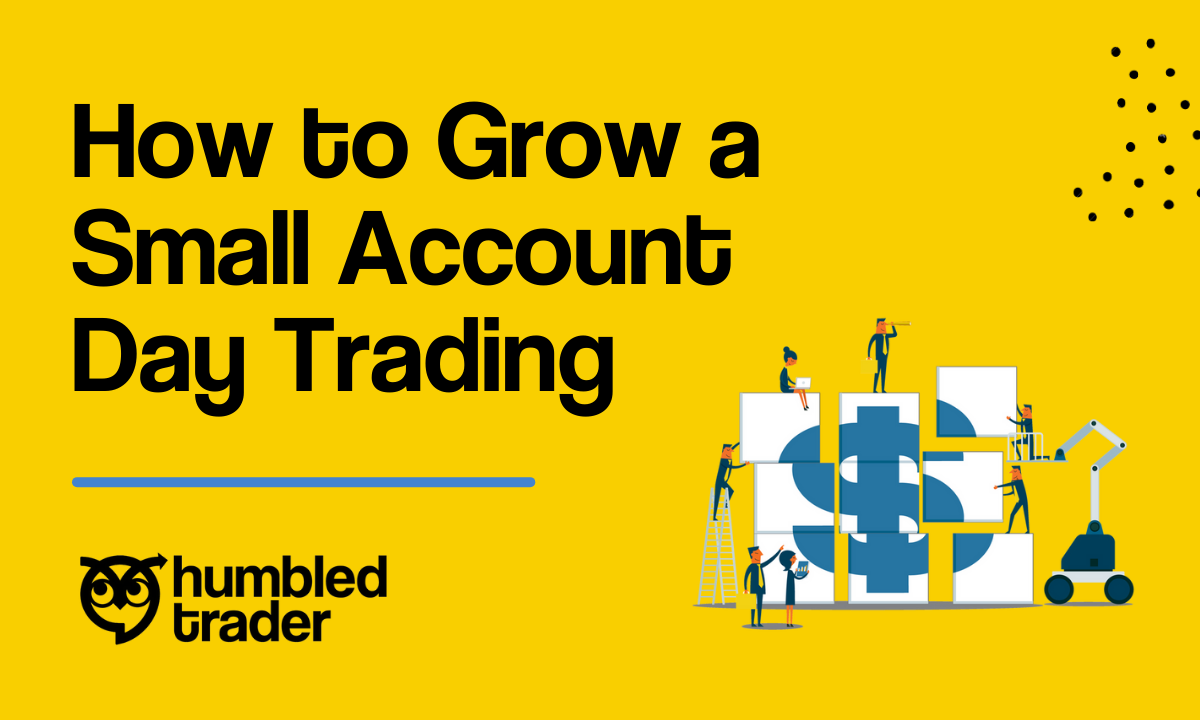Strategies for Success: How to Grow a Small Account Day Trading

How to grow a small account from day trading? That’s the question many beginner traders would ask. Not a sweat, here are the essential tips or strategies you might take reference to start your journey!
How to Grow A Small Account Tip #1: Trading Momentum on Mid-Cap/Large-Cap Stock
For many beginner traders, myself included, trading penny stocks is often seen as a step towards achieving our financial goals. However, trading penny stocks is not the only path to growing a small account. Another option is to trade momentum on mid-cap and large-cap stocks, which can also be profitable.
Why should you not only trade penny stocks?
Let’s face the reality. There aren’t going to be parabolic stocks every day for you to ride the waves. You may end up forcing trades and lose all the profits from the previous months. (That’s not sustainable to develop a trading career like that!)
Besides, incorporating trading mid-cap/large-cap stocks into my trading playbook has made my trading more adaptable to different market conditions.
Trading penny stocks vs large-cap stocks: misconceptions
Okay, that might not be convincing enough. Here are six misconceptions to tell you about trading penny stocks and large-cap stocks:
Misconception #1: Trading large-cap stocks is challenging because you're competing with smart money.
Smart money refers to the capital coming from institutions. You might have the impression that it could be challenging to win over them. However, the opposite is true. Usually, their trading moves will leave trails on the price actions (in large-cap trading, you have your volume as a reliable key indicator and the trend to follow) and make it easier for retail traders like us to notice.
Dump money refers to the small investors who are not influential or unpredictable in the price action. This might not be significant enough to set up a consistent trading plan.
Misconception #2: Trading large-cap stocks is too expensive for a small account under $5,000
When you first begin trading, you might think that large-cap stocks are just too expensive for a small account to trade. But that’s not true.
Take a look at the example here. $PCG was a stock-in-play last week. It has a market cap of 3 billion, which is considered a mid-cap stock. However, it was trading around $6, similar to another small-cap stock, XNET. Generally, mid-cap and large-cap stocks provide us with a significant trading range, especially when they have catalysts such as earnings and deals. Trading penny stocks is a sure win (Without considering the risks)
$XNET is a small-cap blockchain penny stock that was very hot. You can see it spiked from $3 to $4.8 at the close on Friday. And opened at $6 on Monday, Oct 28.
So let’s say, with a small account, you only want to put $3000 exposure into this trade. And you pick up 500 shares of XNET at the $6 breakout, and you sell into the pop at $6.30. So that's 30 cents a share, which is a $150 gain. For a small account under $5000, that’s a very solid profit. But what a lot of newer traders with small accounts cannot handle is the volatility of these penny stocks. When a penny stock price fluctuates from $ 5.75 to $6 in 3 minutes, then squeezes to $6.80 in 5 seconds, then drops back down to $5.80 in 2 minutes… It's hard not to get emotional watching this price action when you have your hard-earned money on the line.
But trading mid-cap and large-cap stocks is way less volatile and much less stressful than trading small-cap penny stocks because mid-cap and large-cap stocks tend to stick to the trend once it’s formed! (Personal story: I remember when I started in 2014, I was pulling my hair out trading these volatile penny stocks. I swear, I aged like 5 years in just 6 months! (No jokes here!)
Misconception #3: Trading mid-cap/large-cap stocks has no fundamental advantage
In the mid-cap and large-cap markets, there's almost always daily fresh news and headlines that will provide opportunities for us traders. It could be China tariff news, earnings, and guidance, FDA approvals with biotech stocks, street analyst upgrades, downgrades, or deals and agreements between these publicly traded companies. So, on top of the consistent trend of mid-cap and large-cap stocks we have mentioned before, how could we not have the advantage of trading mid-cap and large-cap stocks?
Misconception #4: Patterns do not work on mid-cap/large-cap stocks
What works well for me in large-cap trading, is trading gap breakouts and shorting the gap fill. And yes, while I don't buy breakouts in penny stocks, I don’t hesitate to buy breakouts trading large-cap stocks.
The good news is that many of the textbook technical setups, like the descending triangle, the wedge breakout, or the Lambo flag formation, work well in large-cap stocks. What I’m trying to say is that if you want to trade purely based on technical patterns, trading large caps could be a friendlier choice.
Misconception #5: Shorting is not accessible for mid-cap/large-cap stock
Another benefit is that these mid-caps and large-caps are much more accessible for small accounts. If you have a margin account, you could pretty much always find free or cheap short loans on them. And you do not have to worry about not being able to access hard-to-borrow penny stocks.
3 Essential Tips to Trade Penny Stocks
Focusing on the market cycle
So what helped build my small account was to only trade small-cap stocks during the hot cycles; generally speaking, March to April and October to December are the months that favor that setup.
While the small caps are slow, I would redirect my focus to the mid-caps and large caps, which are trading in much bigger ranges and volumes.
Focusing on 1-2 penny stocks
Focusing on one or two penny stock long setups helped, but more importantly, I only trade and look for these small-cap stocks in the market conditions that favor those setups. Why? Simply put, most beginner traders only have the account size to buy or go long with stocks.
Take advantage of trader’s psychology
Whereas when trading penny stocks, it's much more important to use trader psychology, not follow the crowd and the alerts, and trade the traders on the other side. Because if you’re not trading against the dumb money in small-cap penny stocks, then you could be the dumb money.
How to Grow A Small Account Tip #2: Buy the Dip Strategy
This is my favorite long-term strategy. I used to grow my small trading account trading part-time while working a full-time job, and these are the 3 main criteria you should be aware of.
Buy the Dip Strategy Criteria #1: Don’t Buy at Stock Breakouts
You hear me saying that all the time: buying the dip, buying the bounce, or longing for the morning panic—it's all just different names for the same technical trading concept. It’s one of the oldest trading setups in the book because the strategy provides you with better odds of making money from the trade and a higher risk-reward.
But the first thing to do before anything else is to look for a parabolic daily chart.
What does a parabolic daily chart look like?
Let’s take a look at this example CLVS. If you look at the daily chart, the stock was going straight up from mid-November to the beginning of December. That's two weeks straight. There were a few red days down here, but near the end, it was green for 7 days straight.
This kind of chart setup, or "pattern,” if you want to call it that, is what we call parabolic. In a chart set up like this, it means there is a lot of emotional and greedy buying from the buyers; big funds and investors are just pouring their money straight into CLVS after the company announced good earnings and guidance at the beginning of November.
What should you do when you see a parabolic chart?
So knowing the good news, and seeing the nice daily breakouts are great, but you do not want to buy breakouts on low-float penny stocks, which could turn into fake outs. (These low-float stocks can have quick price spikes of around 10 cents, followed by significant drops of 30 to 50 cents.)
Yes, you definitely could make money buying breakouts. However, the risk-to-reward ratio is usually terrible. That’s not a consistent strategy, especially when you’re trying to build your small trading account. I prefer to buy the dips at the support level on stocks with a strong parabolic daily chart like CLVS. Now you must be wondering, okay, how exactly do we find these strong support levels to buy the bounce?
And that brings us to the second criterion.
Takeaway: Don’t buy these whole-dollar breakouts or high-of-the-day breakouts.
Buy the Dip Strategy Criteria #2: Draw Support Levels from the Daily Chart
The second criterion for this "buy the dip" strategy is to identify support levels from the daily chart. But note that not all support levels are suitable for buying. The goal is to find the strongest support levels typically found on the daily chart.
How to find the support level?
So using our parabolic daily chart example CLVS, you can see there's a support level on the daily chart around this 11.60 area. That's a support line from the end of October 2018, and this support was broken down later on in July 2019. So when a support line is broken, it becomes resistance later.
Buy the dip at the support level
What if we wait for the stock to break out further the next day and then buy the dip?
You can see CLVS broke the previous day's high at 11.6 early in the morning and ran to a high of 12.65. when a resistance level is reclaimed, that then becomes support. After it reached the highs, the stock pulled back and dipped to the 11.67 level. That's the dip area we were looking at on the daily chart to set up our trades.
Support and resistance levels are not exact
These daily support and resistance levels are never going to be exact to the cent. They are indications of a rough area of supply and demand. And if you were waiting for that dip too long, you would then put the stop under the breakdown of support level.
Stop Loss Set Up Tip: Give the position room to risk
Make sure to give it some room, like 10 or 15 cents, depending on the float and volatility. If you put stops right at entry or too close to the support level, you’ll always get stopped out.
Takeaways: Achieving success requires being patient, having a support line, and being able to adjust your buying strategy. Experience allows you to be flexible, even if you miss out on initial opportunities or encounter unexpected setbacks.
Buy the Dip Strategy Criteria #3: High Short Interest
I refer to this third criterion as the Japanese chili spice on ramen. It's unnecessary to purchase the dip on morning panic sell-offs, but it enhances the setup and makes it even more advantageous for trading stock. And the criteria for this setup is high short interest. Do you remember when we discussed the first criterion, which is a parabolic daily chart? A stock is considered parabolic when it has been increasing rapidly for a few consecutive days without experiencing any significant pullbacks.
And at the same time, whenever there’s a stock that’s going up and up to the moon, there’s always funds and people trying to short it. Because yes, technically speaking, if a chart that looks like this is extended, it should sell off, right? It should experience some sort of correction or pullback.
Check out the high short interest.
This is where high short interest comes into play. When there are a large number of investors or funds betting against a stock, it creates the potential for a short squeeze. A short squeeze occurs when the price of a stock starts to rise rapidly, forcing short sellers to cover their positions by buying shares, which further drives up the price.
Where can I check the high short interest on a stock?
The best way to get the most updated data is to Trade Ideas. I have the scanner set up to show me the short interest in the morning gap scanners and the mid-day momentum scanner. And you can also see it in the stock details.
Alternatively, you can check the short percentage details on Finviz and shortsqueeze.com.
Both of these sites are free, but there is some delay. Overall, it still gets the job done.
Usually, over 20% of short interest is when I consider the stock to be highly shorted, and even better if it's over 50%.
So, when looking for stocks to buy the dip, consider those with high short interest. This increases the chance of a short squeeze and can lead to a rapid price increase. The combination of a parabolic daily chart, strong support levels, and high short interest creates a strong setup for buying the dip.
Humbled Trader Tips: Be patient for the perfect setup to come to you
If you are trading these strategies, you need to be patient and wait for the perfect setup to come to you. It's okay if you miss some of the setups.
How to Grow A Small Account Tip #3: Build your discipline
This part is simple. Just ask yourself the questions to understand how well your discipline goes.
Do you spend at least 2 hours trading every day?
Do you have a pre-market planning process? How’s your morning routine before you even sit down in front of your computer? After you’re done for the day, do you have a routine for reviewing your trades?
Discipline is the foundation of becoming a good trader, and journaling is a good start to building your discipline. Start with something small. Maybe a setup idea and paper trade the idea and find out if this works in the end.
Conclusion: Never Force Trade
Maybe in the slower months that don't favor your setup, that’s the time to paper trade and practice large-cap setups. The focus should be to preserve the capital and profit you've already made with your small account and not force trades using the same strategy every single day.
If you want to see more of how I trade large-cap stock earnings gap ups and gap downs, make sure to check out our Humble Traders Community, where I will share all of my trading resources, including trading approaches, trading psychology, and risk management skills, in detail.
Join the Humbled Trader Community today


